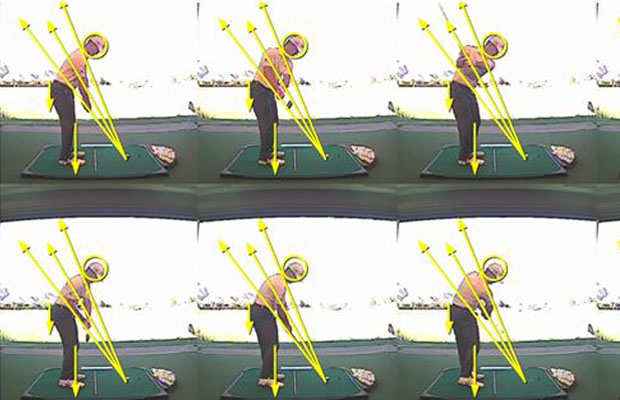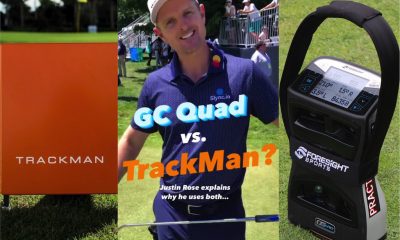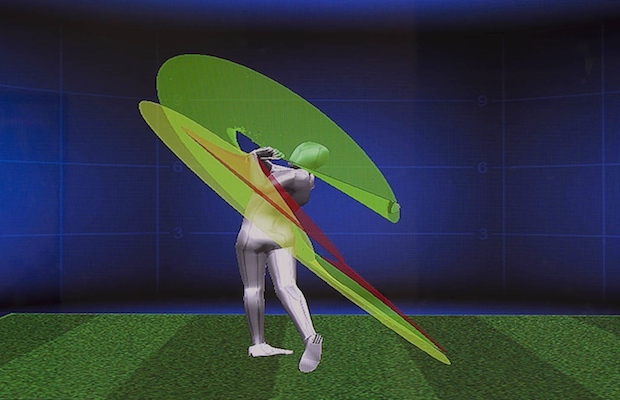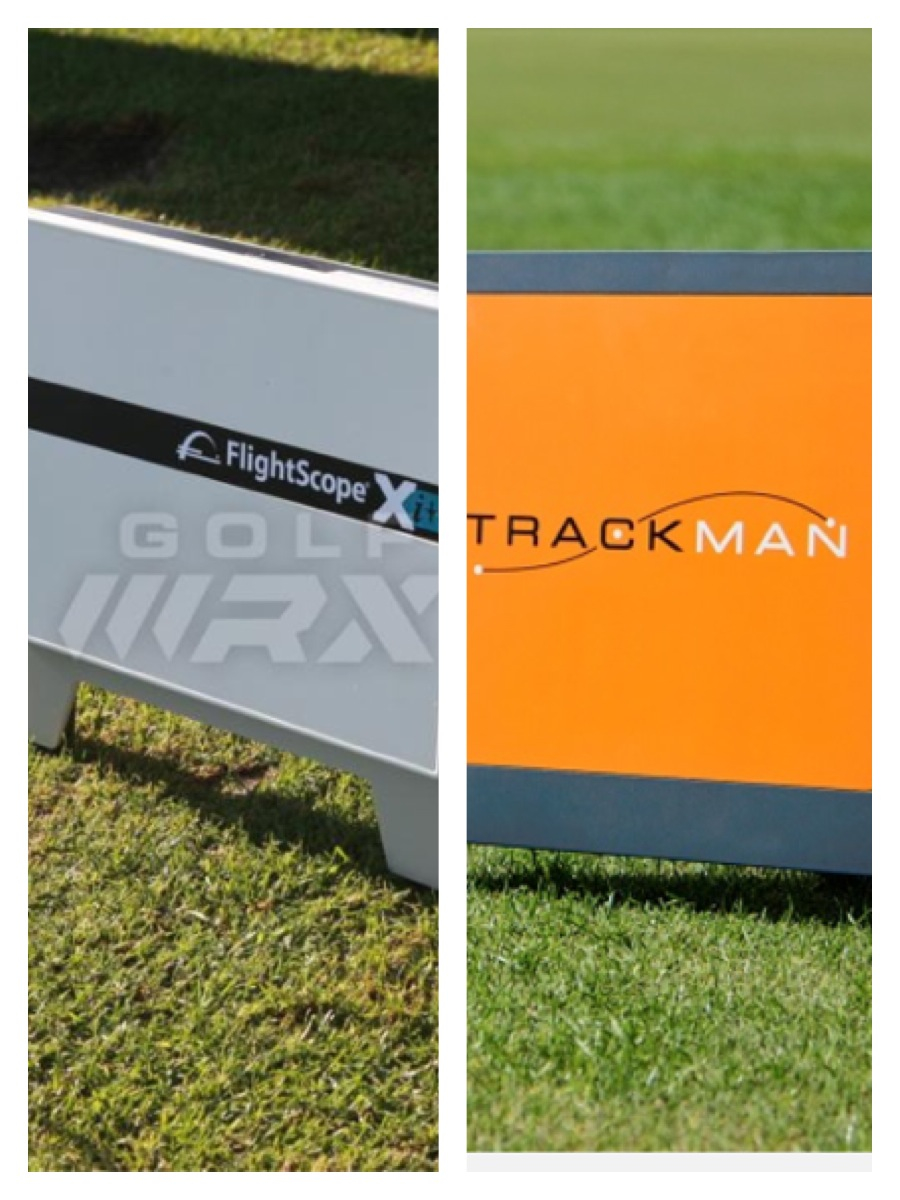Instruction
To use video, Trackman or both?

Video analysis has indeed changed the way we practice, play and view our golf swings. With the advent of Doppler radar launch monitors like Trackman and FlightScope, teachers now understand that “position golf” isn’t the way to help many golfers play their best. In fact, there are some positions that indeed look better on camera, but the player cannot put the ball in the hole from there.
Trackman users such as myself will tell you that if you use only video you can be fooled when you draw lines, as video only represents a 2D view of your swing. Trackman and FlightScope show impact and ball data in 3D, which is more accurate. But sometimes, trying to consistently hit the “proper” numbers can be just as harmful.
Some teachers only use video, others only use Trackman or FlightScope, but the burning question remains: “What is more important to the player?”
This Trackman screen gives instructors the detailed numerical data necessary to analyze each shot hit in the utmost detail.
I have been in the instructional world teaching golf full time for more than 20 years, and I have used video and Trackman extensively. I have seen issues with BOTH technologies if not conglomerated in the correct way. Some teachers only use video, drawing lines all over the screen. They focus on each position as if it were gospel. This type of video instruction can be very detrimental to the students who possess an idiosyncratic characteristic not allowing them to hit the “key” position. On the flip side, I know Trackman-based teachers who hardly look up from their data screens. When data is an instructor’s only focus, it can also be a problem. Golfers are not robots, and no golfer is consistent to get the proper numbers every time.
So what’s the solution?
In my opinion, instructors must merge the benefits of video and Trackman/FlightScope in order to be the best teacher they can be for the student at hand. If students need a less mechanical focus, it might be best to use the Trackman/FlightScope. An instructor can have them hit a few shots trying to make the numbers move in a more positive direction. Other times, students might be too caught up in trying to make the data too perfect. So an instructor might want to flip on the video to show that just because a golfer’s angle of attack is a touch too much down, they are swinging just fine from the video perspective.
It is up to the TEACHER to figure out the personality of their students and make sure their lessons work best for each player. A learning style that helps the student is the one that should strived for, not the one that is most comfortable for the teacher!
A note for golfers: If your instructor uses a style that sways toward too much video or too much Trackman and it is frustrating you, then you must have a conversation with them. You will NOT improve using a learning style that goes against your natural style of learning!
Read More Tom Stickney II : What Flightscope and Trackman can tell you (and me)
Instruction
The Wedge Guy: Beating the yips into submission

There may be no more painful affliction in golf than the “yips” – those uncontrollable and maddening little nervous twitches that prevent you from making a decent stroke on short putts. If you’ve never had them, consider yourself very fortunate (or possibly just very young). But I can assure you that when your most treacherous and feared golf shot is not the 195 yard approach over water with a quartering headwind…not the extra tight fairway with water left and sand right…not the soft bunker shot to a downhill pin with water on the other side…No, when your most feared shot is the remaining 2- 4-foot putt after hitting a great approach, recovery or lag putt, it makes the game almost painful.
And I’ve been fighting the yips (again) for a while now. It’s a recurring nightmare that has haunted me most of my adult life. I even had the yips when I was in my 20s, but I’ve beat them into submission off and on most of my adult life. But just recently, that nasty virus came to life once again. My lag putting has been very good, but when I get over one of those “you should make this” length putts, the entire nervous system seems to go haywire. I make great practice strokes, and then the most pitiful short-stroke or jab at the ball you can imagine. Sheesh.
But I’m a traditionalist, and do not look toward the long putter, belly putter, cross-hand, claw or other variation as the solution. My approach is to beat those damn yips into submission some other way. Here’s what I’m doing that is working pretty well, and I offer it to all of you who might have a similar affliction on the greens.
When you are over a short putt, forget the practice strokes…you want your natural eye-hand coordination to be unhindered by mechanics. Address your putt and take a good look at the hole, and back to the putter to ensure good alignment. Lighten your right hand grip on the putter and make sure that only the fingertips are in contact with the grip, to prevent you from getting to tight.
Then, take a long, long look at the hole to fill your entire mind and senses with the target. When you bring your head/eyes back to the ball, try to make a smooth, immediate move right into your backstroke — not even a second pause — and then let your hands and putter track right back together right back to where you were looking — the HOLE! Seeing the putter make contact with the ball, preferably even the forward edge of the ball – the side near the hole.
For me, this is working, but I am asking all of you to chime in with your own “home remedies” for the most aggravating and senseless of all golf maladies. It never hurts to have more to fall back on!
Instruction
Looking for a good golf instructor? Use this checklist

Over the last couple of decades, golf has become much more science-based. We measure swing speed, smash factor, angle of attack, strokes gained, and many other metrics that can really help golfers improve. But I often wonder if the advancement of golf’s “hard” sciences comes at the expense of the “soft” sciences.
Take, for example, golf instruction. Good golf instruction requires understanding swing mechanics and ball flight. But let’s take that as a given for PGA instructors. The other factors that make an instructor effective can be evaluated by social science, rather than launch monitors.
If you are a recreational golfer looking for a golf instructor, here are my top three points to consider.
1. Cultural mindset
What is “cultural mindset? To social scientists, it means whether a culture of genius or a culture of learning exists. In a golf instruction context, that may mean whether the teacher communicates a message that golf ability is something innate (you either have it or you don’t), or whether golf ability is something that can be learned. You want the latter!
It may sound obvious to suggest that you find a golf instructor who thinks you can improve, but my research suggests that it isn’t a given. In a large sample study of golf instructors, I found that when it came to recreational golfers, there was a wide range of belief systems. Some instructors strongly believed recreational golfers could improve through lessons. while others strongly believed they could not. And those beliefs manifested in the instructor’s feedback given to a student and the culture created for players.
2. Coping and self-modeling can beat role-modeling
Swing analysis technology is often preloaded with swings of PGA and LPGA Tour players. The swings of elite players are intended to be used for comparative purposes with golfers taking lessons. What social science tells us is that for novice and non-expert golfers, comparing swings to tour professionals can have the opposite effect of that intended. If you fit into the novice or non-expert category of golfer, you will learn more and be more motivated to change if you see yourself making a ‘better’ swing (self-modeling) or seeing your swing compared to a similar other (a coping model). Stay away from instructors who want to compare your swing with that of a tour player.
3. Learning theory basics
It is not a sexy selling point, but learning is a process, and that process is incremental – particularly for recreational adult players. Social science helps us understand this element of golf instruction. A good instructor will take learning slowly. He or she will give you just about enough information that challenges you, but is still manageable. The artful instructor will take time to decide what that one or two learning points are before jumping in to make full-scale swing changes. If the instructor moves too fast, you will probably leave the lesson with an arm’s length of swing thoughts and not really know which to focus on.
As an instructor, I develop a priority list of changes I want to make in a player’s technique. We then patiently and gradually work through that list. Beware of instructors who give you more than you can chew.
So if you are in the market for golf instruction, I encourage you to look beyond the X’s and O’s to find the right match!
Instruction
What Lottie Woad’s stunning debut win teaches every golfer

Most pros take months, even years, to win their first tournament. Lottie Woad needed exactly four days.
The 21-year-old from Surrey shot 21-under 267 at Dundonald Links to win the ISPS Handa Women’s Scottish Open by three shots — in her very first event as a professional. She’s only the third player in LPGA history to accomplish this feat, joining Rose Zhang (2023) and Beverly Hanson (1951).
But here’s what caught my attention as a coach: Woad didn’t win through miraculous putting or bombing 300-yard drives. She won through relentless precision and unshakeable composure. After watching her performance unfold, I’m convinced every golfer — from weekend warriors to scratch players — can steal pages from her playbook.
Precision Beats Power (And It’s Not Even Close)
Forget the driving contests. Woad proved that finding greens matters more than finding distance.
What Woad did:
• Hit it straight, hit it solid, give yourself chances
• Aimed for the fat parts of greens instead of chasing pins
• Let her putting do the talking after hitting safe targets
• As she said, “Everyone was chasing me today, and managed to maintain the lead and played really nicely down the stretch and hit a lot of good shots”
Why most golfers mess this up:
• They see a pin tucked behind a bunker and grab one more club to “go right at it”
• Distance becomes more important than accuracy
• They try to be heroic instead of smart
ACTION ITEM: For your next 10 rounds, aim for the center of every green regardless of pin position. Track your greens in regulation and watch your scores drop before your swing changes.
The Putter That Stayed Cool Under Fire
Woad started the final round two shots clear and immediately applied pressure with birdies at the 2nd and 3rd holes. When South Korea’s Hyo Joo Kim mounted a charge and reached 20-under with a birdie at the 14th, Woad didn’t panic.
How she responded to pressure:
• Fired back with consecutive birdies at the 13th and 14th
• Watched Kim stumble with back-to-back bogeys
• Capped it with her fifth birdie of the day at the par-5 18th
• Stayed patient when others pressed, pressed when others cracked
What amateurs do wrong:
• Get conservative when they should be aggressive
• Try to force magic when steady play would win
• Panic when someone else makes a move
ACTION ITEM: Practice your 3-6 foot putts for 15 minutes after every range session. Woad’s putting wasn’t spectacular—it was reliable. Make the putts you should make.
Course Management 101: Play Your Game, Not the Course’s Game
Woad admitted she couldn’t see many scoreboards during the final round, but it didn’t matter. She stuck to her game plan regardless of what others were doing.
Her mental approach:
• Focused on her process, not the competition
• Drew on past pressure situations (Augusta National Women’s Amateur win)
• As she said, “That was the biggest tournament I played in at the time and was kind of my big win. So definitely felt the pressure of it more there, and I felt like all those experiences helped me with this”
Her physical execution:
• 270-yard drives (nothing flashy)
• Methodical iron play
• Steady putting
• Everything effective, nothing spectacular
ACTION ITEM: Create a yardage book for your home course. Know your distances to every pin, every hazard, every landing area. Stick to your plan no matter what your playing partners are doing.
Mental Toughness Isn’t Born, It’s Built
The most impressive part of Woad’s win? She genuinely didn’t expect it: “I definitely wasn’t expecting to win my first event as a pro, but I knew I was playing well, and I was hoping to contend.”
Her winning mindset:
• Didn’t put winning pressure on herself
• Focused on playing well and contending
• Made winning a byproduct of a good process
• Built confidence through recent experiences:
- Won the Women’s Irish Open as an amateur
- Missed a playoff by one shot at the Evian Championship
- Each experience prepared her for the next
What this means for you:
• Stop trying to shoot career rounds every time you tee up
• Focus on executing your pre-shot routine
• Commit to every shot
• Stay present in the moment
ACTION ITEM: Before each round, set process goals instead of score goals. Example: “I will take three practice swings before every shot” or “I will pick a specific target for every shot.” Let your score be the result, not the focus.
The Real Lesson
Woad collected $300,000 for her first professional victory, but the real prize was proving that fundamentals still work at golf’s highest level. She didn’t reinvent the game — she simply executed the basics better than everyone else that week.
The fundamentals that won:
• Hit more fairways
• Find more greens
• Make the putts you should make
• Stay patient under pressure
That’s something every golfer can do, regardless of handicap. Lottie Woad just showed us it’s still the winning formula.
FINAL ACTION ITEM: Pick one of the four action items above and commit to it for the next month. Master one fundamental before moving to the next. That’s how champions are built.
PGA Professional Brendon Elliott is an award-winning coach and golf writer. You can check out his writing work and learn more about him by visiting BEAGOLFER.golf and OneMoreRollGolf.com. Also, check out “The Starter” on RG.org each Monday.
Editor’s note: Brendon shares his nearly 30 years of experience in the game with GolfWRX readers through his ongoing tip series. He looks forward to providing valuable insights and advice to help golfers improve their game. Stay tuned for more Tips!



















Raka Agung
Jan 17, 2014 at 7:47 pm
Great article Tom. Really love to have regular access to Trackman/Flight Scope
However for most if us here, access to that system would be expensive and difficult.
Based in your experience have you ever used sensor system that embedded in player hands or clubs, such as golfsense? Is it usefull?
Tom Stickney
Jan 17, 2014 at 9:44 pm
Great question; no I have not, but anything is better than nothing in my opinion…
Frank
Jan 16, 2014 at 12:05 am
This is why I like instructors like Mark Crossfield on You Tube. He works in both spectrum. I have learned more from his posts than any instructor that I have paid money to learn from. By using the drills he teaches and advice he give, I have bettered my game by 6-8 strokes a round and had a record year for myself.
Tom Stickney
Jan 16, 2014 at 12:47 am
Each of us have our strengths for sure.
J
Jan 15, 2014 at 10:21 pm
Flightscope is garbage compared to Trackman. I don’t get why this article talks about video vs trackman because trackman has video built in. If you have access to trackman and refuse to use it your ignorance is more like stupidity. Both student and teacher need to be held accountable at all times.
Tom Stickney
Jan 16, 2014 at 12:47 am
My article speaks about video and tm because some students don’t have access to both. The student should use the tools that work best for their game.
Nick
Jan 14, 2014 at 11:48 pm
Great article, Tom. It should be required reading for every teaching professional.
Tom Stickney
Jan 15, 2014 at 12:51 am
Thx!
Paul
Jan 14, 2014 at 11:14 am
Great article, and that aoa is crazy tom! you get alot out of that 100mph swing!
For me personally, I feel like I can learn more by seeing the data (with trackman) as opposed to someone telling me that “x” is happening and you need to do “y”. With my instructor, for example, I have a slight ott move, and just by being in a room by myself with trackman for the first time I fiddled with my swing to try to manipulate my path. For me, I learn best when I can see the data and interpret it, as opposed to listening, digesting the info, and trying to implement it. He will come in every 20 mins or so and check up on things and discuss what I am doing and offer advice, but it is a much easier way to learn cause and effect.
Tom Stickney
Jan 14, 2014 at 1:55 pm
I set it for 14,000 feet so it goes farther…makes me look better! Ha. Seriously, it’s nice to experiment with feels to see what works best.
Ben
Jan 14, 2014 at 10:32 am
What if your local option is on-range instruction with no video or trackman/flightscope? What do you recommend then?
Tom Stickney
Jan 14, 2014 at 1:56 pm
You must always do best with what tools you have available. They are not a necessity but they are nice to have.
Graeme
Jan 14, 2014 at 8:53 am
I practiced position golf all my junior days and even though it looked good, I hit a brick wall when I got to 3 handicap at 15yrs old. Now with better knowledge with thanks to technology like Trackman Ive now recently reduced my handicap to +2. I’d personally rather stay away from video technology but do understand that for those that like visual learning it can be of some benefit to see the before & after but apart from that, video gets a big thumbs down from me.
Todd Dugan
Jan 14, 2014 at 8:14 am
Radar and video are simply tools which allow the skilled user to diagnose and prescribe better. In the hands of the unskilled, they are of little use.
Tom Stickney
Jan 14, 2014 at 9:13 am
All technology is only as good as the operator using it for sure…thx.
Johnny Appelseed
Jan 14, 2014 at 6:00 am
Ben Hogan didnt need this and neither do it. Its a ball and a stick. Get up there and hit it
Ian
Jan 14, 2014 at 12:33 pm
That’s laughable… If Hogan had access to track man he would’ve been all over it.
jmplautz
Jan 14, 2014 at 2:13 pm
Hogan was a big proponent of using video analysis. Was a very early adopter. If he was willing to use that, it’s not a big stretch to think that he would use modern technologies.
Andrew Cooper
Jan 15, 2014 at 3:38 am
No question Hogan would have used the new technology (and was an early video user) but would it have made him a better golfer?
Russel Johnson
Jan 14, 2014 at 1:10 am
Tom,
Another great article…. I believe in Trackman and all that it has too offer. I like you have a long history of teaching without this technology. Now true knowledge can be brought to the fore front and our thoughts can be validated numerically. I believe marrying the two styles is the best way to get the give info without that is confusing. Establishing a baseline with the Trackman then using that to help solve the cause and effect. I have found that to be a very effective way to balance old and new teachings.
Tom Stickney
Jan 14, 2014 at 2:28 am
That’s how I try and use my v1 system and trackman daily…you’re spot on sir. Thx.